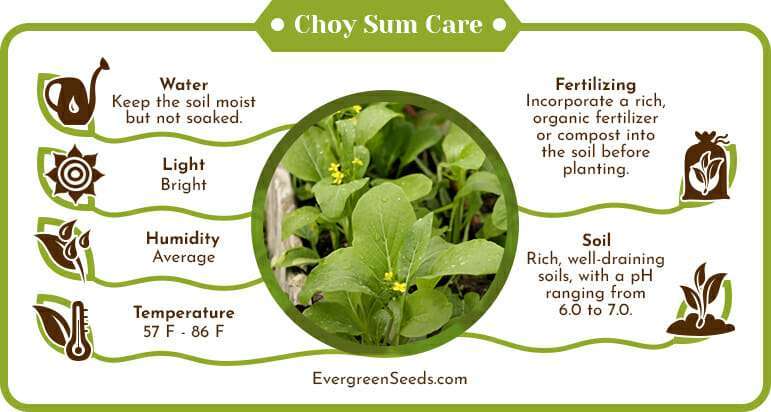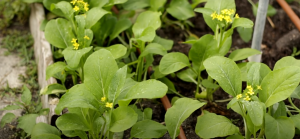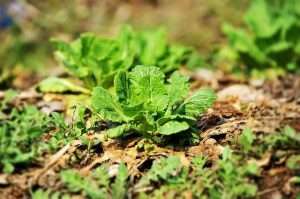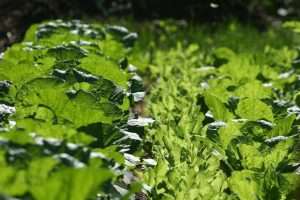- When Are Raspberries Ready to Pick: A Comprehensive Guide for Gardeners - July 11, 2024
- When Are Red Delicious Apples Ready to Pick: Essential Harvesting Tips - July 11, 2024
- When Are Snow Peas Ready to Pick: Essential Harvest Tips - July 11, 2024
 Choy sum of the Brassicaceae family, also known as yu choy in Cantonese, is a type of Chinese flowering cabbage of the Brassica genus.
Choy sum of the Brassicaceae family, also known as yu choy in Cantonese, is a type of Chinese flowering cabbage of the Brassica genus.
Healthy and delicious, it’s best eaten fresh. Unfortunately, it can be difficult to find at markets or stores, but don’t despair!
In this guide, we’ll show you how to grow Choy sum at home and the various ways you can cook with it.
JUMP TO TOPIC
What is choy sum?
Choy sum is a leafy vegetable from the Brassicaceae family, making it a distant cousin of mustard and cruciferous vegetables such as broccoli and cauliflower. Native to China, its name translates into English as ‘heart of the vegetable.’ The Latin name for this plant is Brassica rapa var. Parachinensis.
 On average, Chinese choy sum can grow between 6 inches (15 cm) and 8 inches (20 cm) in height, with slender, light green stems and broad, oval-shaped leaves. As the plant matures, it produces small clusters of yellow flowers similar to those of the rapeseed plant.
On average, Chinese choy sum can grow between 6 inches (15 cm) and 8 inches (20 cm) in height, with slender, light green stems and broad, oval-shaped leaves. As the plant matures, it produces small clusters of yellow flowers similar to those of the rapeseed plant.
As a result, it is occasionally referred to as an edible rape vegetable. All parts of choy sum are edible, and it is a common ingredient in many Asian dishes.
The green leaves and stalks of choy sum have a distinct flavor, with a mild, green bitterness, peppery and mustardy notes, and a noticeable sweetness compared to other Chinese vegetables.
The taste can be compared to that of broccoli rabe, but it’s much less bitter. Stems and flowers have a crisp yet tender texture when young, but they can develop a more pronounced bitterness the older they get. Leaves have a milder aroma and are best cooked for as little as possible to prevent wilting.
Are bok choy and choy sum different?
Bok choy (Pak Choy) and choy sum are two different cultivars belonging to Brassica rapa, a plant commonly known as field mustard, turnip rape, or bird rape. This vegetable is also the source of several other cultivars related to bok choy and choy sum, including rapini, Napa cabbage, and the humble turnip.
– Size and height
Although choy sum and bok choy are related, there are some distinct differences between these two vegetables. Choy sum is a smaller plant with thin stalks and medium-sized leaves, and it’s quite similar in appearance to broccoli rabe and gai lan. Meanwhile, bok choy is a much taller plant, reaching up to 18 inches (45 cm) in length, with slightly ruffled leaves and iconic thick, white stalks.
However, some varieties of choy sum can look remarkably similar to bok choy. For example, white choy sum has thick, fleshy white stalks that can grow quite tall, and like bok choy, it is also picked before the flowers start growing. The easiest way to tell them apart is the taste.
– Taste
Bok choy has a more noticeable cabbage flavor, light mustard notes, and a bit more fibrous crunch in the stems. On the other hand, Choy sum is sweeter and milder, mostly when young, with a hint of pepper, and tender, juicy stems.
– Are yu choy and choy sum the same?
Yu choy and choy sum are the same plant. Often you will find choy sum sold under the name of yu choy, yu choy sum, or even green sum. Essentially, ‘choy sum’ is used in Cantonese to refer to the plant’s delicate parts, particularly the flowering stems in the middle. Meanwhile, yu choy, often misspelled as ‘yau choy’, is used as a catch-all phrase for this vegetable and refers to the older plants, which have a more pronounced mustard bite.
How to grow choy sum
Choy sum is a delicious and nutritious vegetable. However, it can be challenging to find it fresh in stores. It doesn’t last long after the stems have been cut, and it’s best to eat it as soon as it’s been harvested. This is why we recommend growing choy sum in your garden.
With that in mind, let’s take a look at what you’ll need.
Growing choy sum outdoors

It’s easy to grow choy sum from seeds, and you can either sow them directly in the soil or germinate them indoors. We recommend getting the seeds started in compostable seedling trays. This way, you will have a head start with your crop by having the seedlings ready to move outdoors when all chance of frost has passed.
– When to transplant choy sum
There are several choy sum hybrids you can choose from, each with different growing periods and requirements. When planting it outdoors, the main thing to remember is that this is a cold season crop. Choy sum can tolerate temperatures ranging from 57°F (14°C) to 86°F (30°C). However, colder climates stimulate more abundant growth.
You can plant choy sum several times a year, as both a spring and autumn crop. If you have seedlings that you have germinated inside, you can transplant them to the garden when they each have at least 4 leaves. Avoid planting seedlings outside if temperatures are likely to drop below 50°F (21°C), which can cause bolting later on.
 Soil
Soil
Choy sum needs rich, well-draining types of soils, with a pH ranging from 6.0 to 7.0. Prepare the soil by tilling it and incorporating a rich, organic fertilizer or compost, which will provide the young plants with the nutrients they need to grow. If your garden has thick, clay-heavy soils, ensure soil amendments such as coir, peat moss or bark, which will significantly improve drainage.
 Temperature
Temperature
Temperature is such an important factor when growing choy sum that it has an impact on the flavor. Cold weather results in sweeter, tender stems, while higher temperatures result in plants with a more noticeable bitterness. For tasty harvests, aim for a temperature range of 55°F (13°C) to 77°F (25°C).
– Location
If possible, pick a part of your garden where choy sum can get plenty of light but is sheltered from the intense midday sun. Plant choy sum around 6 inches (15 cm) apart. Smaller varieties, which are typically grown as a spring crop, can be planted closer.
However, cultivars that can take 60 or more days to grow should be given more space and grow best when planted 12 inches (30 cm) apart. Check the specifications on your packet of choy sum seeds to see what works best for your plants.
 Watering and fertilizing
Watering and fertilizing
Choy sum seedlings require thorough watering in the first week to settle. As the plant continues to grow, make sure to keep the soil moist but not soaked. If you have used compost or slow-release organic fertilizer initially, there is no need to provide choy sum with other nutrients as it continues to grow.
As a cold-season crop, choy sum can be damaged by extended periods of drought and heat and scarce minerals and nutrients in the soil. When plants are stressed this way, they start to bolt, producing flowers and seeds before reaching full maturity. The result is a crop of choy sum with thin flower stalks and very few leaves, with a very unpleasant, bitter taste.
How long does choy sum take to grow?
Choy sum seeds typically take 7 days to germinate. Depending on the variety, growth periods can vary drastically, with some hybrids being ready for harvest as early as 25 days after sowing. The average growth time across most types ranges between 50 and 70 days since the seeds were sown.
All parts of choy sum are edible, so harvesting it depends on which parts you’re planning to eat, as well as the variety you have grown. Hybrids that take less than 4 weeks to grow are mostly harvested for their leaves and tender stems. Meanwhile, those that take up to 70 or even 80 days are typically allowed to flower, with stems, leaves, and flowers harvested simultaneously.
To harvest choy sum, you can use a sharp knife to either cut the entire plant off at the base or snip the stalks growing in the center. The first method works best for young plants. On the other hand, the second method, also known as the cut-and-come-again method, is used if you want to enjoy a repeated harvest throughout the growing season.
Choy sum pests and problems
Your choy sum crop will be visited by the same kind of pests and insects as cabbage, broccoli, kale, and so on. Aphids are attracted to the young, tender shoots, while slugs and caterpillars find the leaves very tasty. If you notice discoloration on the leaves in the shape of lines or spirals, that’s usually a sign of the leafminer bug, another common pest.
Meanwhile, pale yellow spots and gray mold on the leaves indicate a mildew fungal infection.
Often, growing vegetables in greenhouses is a great way to prevent bugs and insects from eating your crop, yet we understand that’s not always an option. Whenever possible, we recommend using organic methods to combat pests and diseases on your plants instead of insecticides. Here are some tips for tackling the most common problems.
– Aphids
Hose down your choy sum plants with a blast of water to remove the colonies of mature specimens. Ladybug larvae are natural predators of aphids, and you will find them for sale in many garden centers and nurseries. They will help control aphid populations naturally, without any ill effects on the plant.
– Slugs, snails, and caterpillars
These pests are easy to identify and control due to their size. Inspect your choy sum leaves daily and manually remove the culprits when you find them. You can also use row covers to protect the plants from horrible infestations with slugs, snails, or caterpillars.
– Cabbage maggot
The cabbage’s larvae fly, this insect feast on the plants’ roots, and because they live underground, they can be challenging to spot at first. Using row covers can protect your choy sum from adult flies before they lay eggs. Crop rotation, tilling and sanitizing the field can also prevent recurring infestations.
– Mildew
This fungal infection can be very destructive to your crop, but you can control and eliminate it even without using fungicides. The safest way is to spray infested plants with a solution of water and baking soda, applied every week to protect the new growth. As prevention, avoid planting your choy sum too closely together or providing them with excessive watering.
How to cook with choy sum
The tastiest way to cook choy sum is to stir-fry the stems (with flowers and leaves attached) in a bit of peanut oil, with garlic, ginger and fish/soy sauce. The leaves can also be snipped off the stalks and cooked similarly to spinach, either by steaming or blanching them. Meanwhile, you can cook the stems and flowers the same way you would broccoli or Chinese kale and serve them as a side dish.
Choy sum loses much of its aroma and texture the longer it is kept after harvesting. You can store it in your fridge for a couple of days, but eating it fresh is always the best choice. If you’ve had a bountiful harvest of choy sum from your garden, you can also blanch and freeze it for 6 to 8 months. The leaves and stems will become softer in the process, but you can still use them in soups or stews or fill in dumplings.
Are choy sum flowers edible?
Absolutely! You will often find choy sum sold fresh with flowering stalks included. The flowers have the same taste as the leaves and stems, with a tender texture and a mild sweetness, a green bitterness and delicate notes of mustard.
What can you substitute choy sum with?
Due to its unique texture and aroma, it can be challenging to find an exact substitute for choy sum. However, alternatives exist, depending on the kind of dish you’re cooking and the parts of the plant you need to use.
In Asian dishes, gai lan works best as a substitute for choy sum. The flavor is quite similar, although the stems of gai lan are thicker and may require longer cooking times. If you need to substitute white yu choy or varieties where the stems are broad and thick, we suggest bok choy. It has the same crunchy texture, although the aroma is much milder, without the mustardy notes you find in choy sum.
If you can’t find any varieties of Asian leafy greens at your grocery store or market, using Western vegetables from the same family also works. Collard greens can be used as a replacement for choy sum leaves, and broccolini can be used instead of the flowers and stems, while the sweetness and crispy texture of Napa cabbage work well in stir-fries.
Of course, no substitute will completely match the flavor profile of choy sum. This vegetable has an unmistakable taste and consistency. It’s so easy to grow that we recommend going for the real deal whenever you can.












